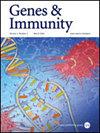Transmission disequilibrium analysis of whole genome data in childhood-onset systemic lupus erythematosus
IF 5
3区 医学
Q1 GENETICS & HEREDITY
引用次数: 0
Abstract
Childhood-onset systemic lupus erythematosus (cSLE) patients are unique, with hallmarks of Mendelian disorders (early-onset and severe disease) and thus are an ideal population for genetic investigation of SLE. In this study, we use the transmission disequilibrium test (TDT), a family-based genetic association analysis that employs robust methodology, to analyze whole genome sequencing data. We aim to identify novel genetic associations in an ancestrally diverse, international cSLE cohort. Forty-two cSLE patients and 84 unaffected parents from 3 countries underwent whole genome sequencing. First, we performed TDT with single nucleotide variant (SNV)-based (common variants) using PLINK 1.9, and gene-based (rare variants) analyses using Efficient and Parallelizable Association Container Toolbox (EPACTS) and rare variant TDT (rvTDT), which applies multiple gene-based burden tests adapted for TDT, including the burden of rare variants test. Applying the GWAS standard threshold (5.0 × 10−8) to common variants, our SNV-based analysis did not return any genome-wide significant SNVs. The rare variant gene-based TDT analysis identified many novel genes significantly enriched in cSLE patients, including HNRNPUL2, a DNA repair protein, and DNAH11, a ciliary movement protein, among others. Our approach identifies several novel SLE susceptibility genes in an ancestrally diverse childhood-onset lupus cohort.儿童期系统性红斑狼疮全基因组数据的传递不平衡分析。
儿童期系统性红斑狼疮(cSLE)患者是独特的,具有孟德尔障碍(早发性和严重疾病)的特征,因此是SLE基因研究的理想人群。在这项研究中,我们使用传播不平衡测试(TDT)来分析全基因组测序数据,这是一种基于家族的遗传关联分析,采用稳健的方法。我们的目标是在一个具有祖先多样性的国际cSLE队列中确定新的基因关联。来自3个国家的42名cSLE患者和84名未受影响的父母接受了全基因组测序。首先,我们使用PLINK 1.9对基于单核苷酸变体(SNV)的(常见变体)进行TDT,并使用高效和可并行的关联容器工具箱(EPCTS)和罕见变体TDT(rvTDT)进行基于基因的(罕见变体)分析,后者应用适用于TDT的多个基于基因的负荷测试,包括罕见变体负荷测试。应用GWAS标准阈值(5.0 × 10-8),我们基于SNV的分析没有返回任何全基因组显著的SNV。基于罕见变异基因的TDT分析确定了许多在cSLE患者中显著富集的新基因,包括DNA修复蛋白HNRNPUL2和纤毛运动蛋白DNAH11等。我们的方法在一个具有祖先多样性的儿童期发病狼疮队列中确定了几个新的SLE易感基因。
本文章由计算机程序翻译,如有差异,请以英文原文为准。
求助全文
约1分钟内获得全文
求助全文
来源期刊

Genes and immunity
医学-免疫学
CiteScore
8.90
自引率
4.00%
发文量
28
审稿时长
6-12 weeks
期刊介绍:
Genes & Immunity emphasizes studies investigating how genetic, genomic and functional variations affect immune cells and the immune system, and associated processes in the regulation of health and disease. It further highlights articles on the transcriptional and posttranslational control of gene products involved in signaling pathways regulating immune cells, and protective and destructive immune responses.
 求助内容:
求助内容: 应助结果提醒方式:
应助结果提醒方式:


